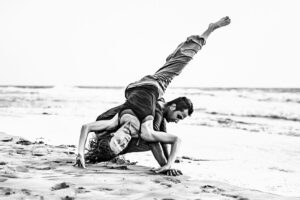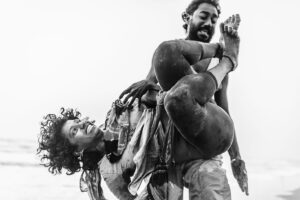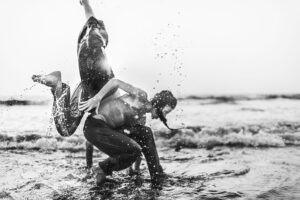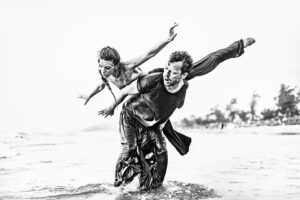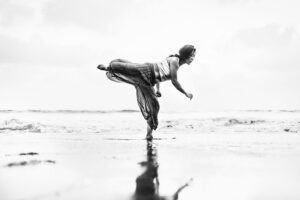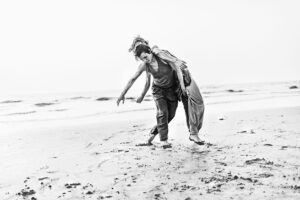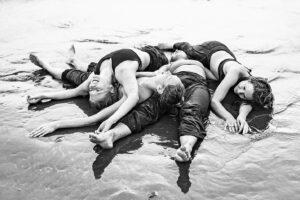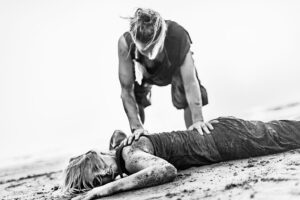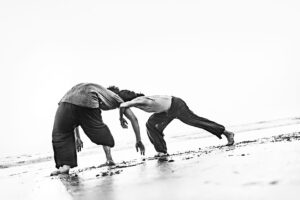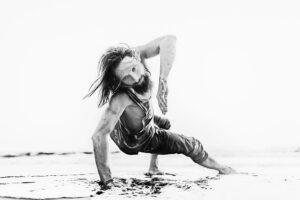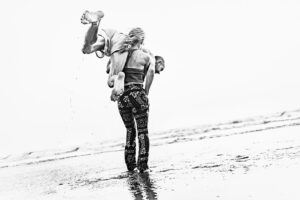Our ability to connect — with ourselves, others, and the planet — is regarded as essential for creating a sustainable world, leading organizations, and improving our well-being. Yet we seldom reflect on the nature of connection itself. What if we are already connected and are simply missing the ability to notice it? Inspired by Martin Buber’s notion of “I and Thou”, this photographic research uses contact improvisation to explore the nature of connection as one’s ability to embrace another “I” while being in genuine contact with one’s own “I.”
ABOUTThe Project
Contact improvisation is a contemporary dance form in which dancers improvise around a shared point of contact. Because the next move is never known in advance, the dancer can only mindfully experience the dance as it emerges, listening inwardly and acting outwardly at the same time.
In this way, the dancers participate in shared co -creation while simultaneously dancing their own dances, unfolding an embodied experience of relationality. The project is an invitation to explore this experience as the photographs form crystallized points of contact with the dance itself.
The project may also be seen as a mirror of my own relationship with connection. I long to be part of something and yet to dance my own dance. In 2017, I spent the winter on Arambol Beach in Goa, India, where hundreds of contact dancers gather for festivals, workshops, and jams every year. I was one of them — with a camera.
In this way, we did 25 photo sessions with more than 50 dancers who came from five continents, were aged from their early 20s to 60, and had various levels of experience. In each case, a dynamic and improvised dance emerged in which none of us knew what the next move would be or from what angle the following picture would be taken.
Abhilash Ningappa (IND)
Aditya Sasidharan (IND)
Anjelika Doniy (RUS)
Baptiste Sejourne (FRA)
Camille Pierre Behaghel (FRA)
Catherine Caraker (USA)
Daniele Sardella (ITA)
Danielle Allouma (ISR)
Ditte Green-Petersen (SWE)
Dolores Dewhurst Marks (GBR)
Eevi Tolvanen (FIN)
Elliott Ford (GBR)
Genevieve Luicien (IND)
Guru Suraj (IND)
Hugh Stanier (GBR)
Irene Sposetti (ITA)
Jasmine Khan (SWE)
Johanne Hofseth (NOR)
Linda Bottolfs (NOR)
Maanee Chrystal Lyn Joy (AUS)
Matthieu Azul (FRA)
Maviee Mav (IDN)
Max Lundqvist (SWE)
Maya Wuytack (BEL)
Mileen Borgonjon (BEL)
Pau Seguí Barber (ESP)
Pilar Echavarria (COL)
Rafael Zielinski (POL)
Sergio Palomares Vicente (ESP)
Sören Wacker (GER)
Swapna Shree (IND)
Ulli Wittemann (GER)
Vega Luukkonen (FIN)
Wei Xie (CHN)
Xenia Isaeva (RUS)
Zuzanna Bukowski (GER)
Many people from all over the world have contributed to this project. First, I would like to thank the fantastic dancers. I would also like to thank Volker Eschmann and the team behind the Goa Contact Festival 2017 for all their encouragement and support before, during, and after the event. Special thanks to Sören Wacker, who captured some memorable photographs of the project in the making. Many have shared valuable feedback on the photographs and the emerging project, including Eva-Teréz Gölin, Henrik Isaksson Garnell, Urban Jörén, and Susanne Fessé.
I am also grateful to Hanna Wetterstrand and Johan Nilsson for important input on the texts, and to Pierre Guillet de Monthoux for encouraging me to explore the interconnection between management research and art. My special thanks to Isak Åkerlund for taking the project to the next level through the graphic design of this book, as well as being a longstanding friend and someone to lean on during the publication process.
Finally, I would like to thank Johan Nilsson, Hanna Wetterstrand, and Irene Sposetti, with whom it all started. Thank you for being my first teachers and great sources of inspiration and learning as I began reflecting on how contact improvisation could influence my own way of being.
Lasse Lychnell is a photographer, contact improvisation dancer, and management researcher at the Stockholm School of Economics Institute for Research.
PUT YOURSELF INContact
For exhibitions and collaborations:
Lasse Lychnell
+46 702 01 21 22
contact@pointsofcontact.se


